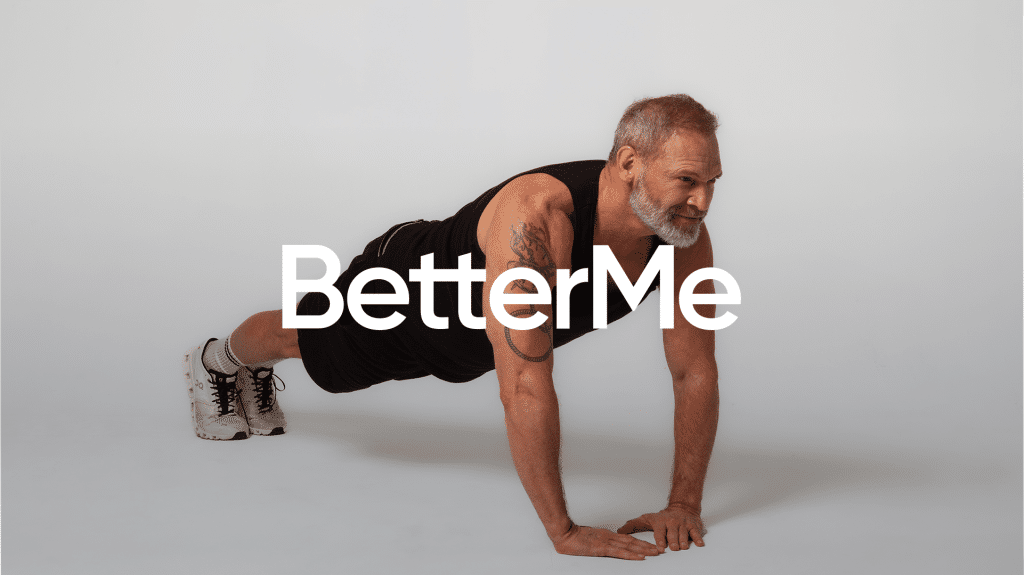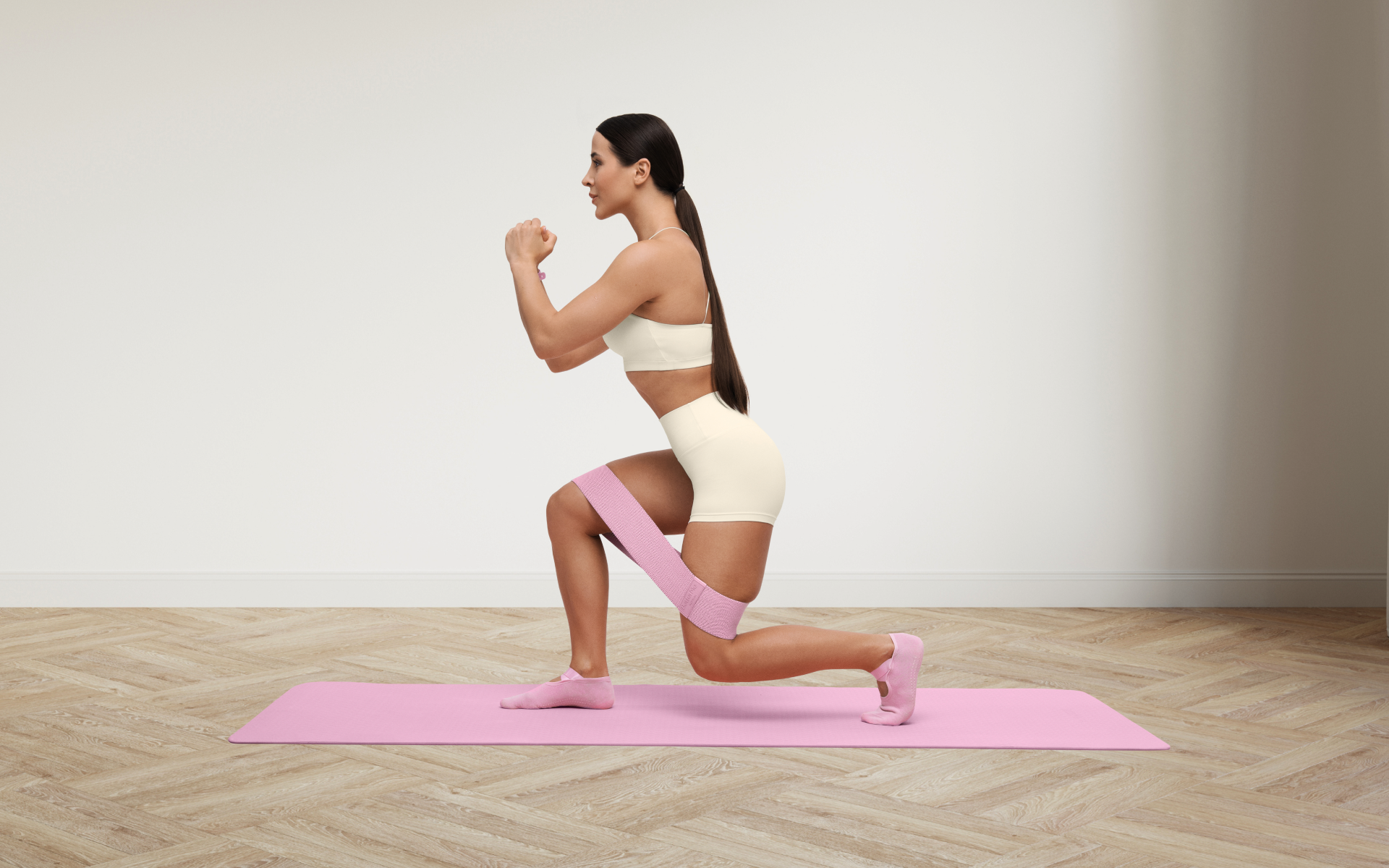Knowing which muscle groups to work together can rest your concerns about maximizing workouts. Of course, knowing which muscle groups, when worked out together would bring you the best results, whether you seek mass, fitness, or full-body routines, is difficult.
Discover the muscle groups, how they help each other, and why you should work specific muscles together to enhance your workout. Then, it’s about planning how many days you exercise and which splits better suit your needs.
What Are the Major Muscle Groups?
The major muscle groups include well-known areas, such as (17):
- Back
- Chest
- Arms
- Core
- Legs
- Shoulders
Yanking yourself back in shape has never been so easy with our game-changing fitness app! Start transforming your life with BetterMe!
Muscle Groups to Work Together: Step-By-Step Guide
The major muscle groups are a good starting point, but you must know more about targeted workouts, why they matter, and exercises to use before diving into schedules. Discover the guidelines that help you set a muscle group workout schedule.
Step 1
Know Why Different Muscle Groups Exercised Together Matters
The Victoria Department of Health states that you have 600 muscles in your body, including three kinds that work together to help you function in daily activities (11):
- Cardiac muscles are those responsible for the beating, contracting, and pumping of blood
- Smooth or involuntary muscles are structured internally and contract with various internal functions
- Skeletal muscles are attached to bones responsible for movement. They’re typically grouped into opposing actions like push and pull
Step 2
Choose How Many Days to Work Out
The American Heart Association recommends working each muscle group at least twice weekly and resting the group for 48 hours between workouts (15). Targeting each muscle group in specific exercises at least twice weekly is excellent.
Those groups should be rested from targeted exercise for 48 hours between workouts allowing the muscle fibers to heal. Beginners will benefit from targeting specific muscle groups on different days. For example, target your legs on Mondays and then again on Wednesdays.
In summary, determine whether you want to work out two, three, four, or five days weekly, which will help you choose the split next. You must also select your days according to your needed rest days. Follow the two-day rest as a beginner to avoid injury or overuse (15).
Step 3
Choose a Workout Combination Split
Depending on your goals, various workout combinations can help you work the right muscle groups together. Let’s see which workout combinations work which muscles together to help you split your routines.
Antagonist Workout Split
Opposing workout combinations to target muscle groups that improve daily functions are great for 3-day and 5-day routines. Exercising muscles that pull and push, such as the triceps and biceps, in one workout combination will help improve both functions equally.
Working the pull muscles too hard may overuse them while ignoring the push muscles, a form of myopathy (11). Myopathy is a collective term for any muscle disorder or imbalance. However, other types of workout combinations may also improve muscle group exercises.
Examples of antagonist training combinations to use on different days:
- Push-pull
- Bicep-tricep
- Chest-back
Complementary Workout Split
Complementary training means you use workout combinations on different days to target larger muscle groups that support the movement of smaller groups (21). It works well for 2-day, 3-day, and 5-day workout routines.
Smaller muscle groups help larger muscles perform specific movements. This split type allows you to work on smaller muscle groups by combining them with larger groups. The combinations are complicated. Examples of complementary muscle groups to target on different days include:
- Quads-calves
- Hamstrings-abs
- Chest-biceps
The Upper-Lower Split
The upper-lower split is another popular choice and works for 3-day weekly routines. Remember to train each muscle group twice weekly while resting them for 48 hours between workouts (15). Hence, this split works better for someone exercising every second day.
This wouldn’t work well for someone exercising five days weekly as some exercises target multiple groups. For example, the back squat muscles worked include everything down your posterior chain (9). You hit the calves, core, back, and hamstrings at once. How can you do any exercise that targets those groups the next day?
Examples of upper-lower split combinations to use every second day:
- Biceps-core
- Shoulders-legs
- Back-quads
Read more: Effective and Simple Bicep Workouts at Home, no Equipment.
Step 4
Choose Exercises by Muscle Group to Add to the Splits
Choosing a split is one step. You’ll also choose exercises that target different muscle groups to include in your split. Some exercises train multiple muscle groups, but the main target lies within the categories below.
Back Muscle Exercises
Back muscles aren’t always on the exercise schedule. They include the trapezius, latissimus dorsi, levator scapulae, and rhomboids (2). Here are 20 back exercises to target this muscle group in your workout combinations include:
- Alternating dumbbell row
- Back extension
- Burpee
- Chinup
- Close-grip seated cable row
- Deadlifts
- Incline dumbbell row
- Inverted row
- Landmine single-arm row
- Lying lateral raise
- Pike-up to Superman
- Reverse-grip pulldown
- Romanian deadlift
- Single-arm dumbbell row
- Straight-arm lat pulldown
- Superman
- Swiss ball leg curl
- Weighted pull-up
- Wide-grip bent over barbell row
- Wide-grip pull-up
Bicep Muscle Exercises
The biceps are a muscle group on their own, composed of a long and short head (3). The biceps play an important role and should work in opposition to the triceps. These 20 exercises will work the biceps in a split:
- Band curl
- Barbell bent over row
- Cable curl
- Cheat curl
- Concentration curl
- Drag curl
- Dumbbell curl
- EZ bar curl
- Hammer curl
- Incline dumbbell curl
- Inverted row
- Overhead press
- Preacher curl
- Reverse-grip barbell row
- Seated cable row
- Spider curl
- Standing dumbbell curl
- Suspension trainer biceps curl
- Underhand seated row
- Zottman curl
Chest Muscle Exercises
The chest muscles are large muscles composed of the pectoralis major and minor. Interestingly, the incline pushup muscles target different portions of the chest from the regular pushup (8). You work the lower chest, deltoids, pecs, and triceps. You can use many chest exercises to target the muscles, but variations can also help target others for a complementary split. These 20 exercises will target the chest muscles:
- Alternating bench press
- Barbell bench press
- Cable crossover
- Chest dip
- Chest flye
- Decline bench press
- Decline pushup
- Dumbell bench press
- Incline dumbbell press
- Incline pushup (8)
- Landmine press
- Low-incline press
- Overhead pull
- Plyo pushup
- Prone flye
- Renegade row
- Resistance band flye
- Reverse-grip double-arm row
- Wide-grip dip
- Wide-grip pushup
Core Muscle Exercises
The core muscles include the transversus abdominus, obliques, rectus abdominus, erector spinae, quadratus lumborum, and hip muscle groups, including the hip flexors (4). Here are 20 exercises that target various muscles around the abs, obliques, and core:
- Alternating renegade row
- Barbell ab rollout
- Bicycle crunch
- Bird dog yoga pose
- Cat cow yoga pose
- Crunch
- Dead bug
- Flutter kick
- Glute bridge
- Hanging leg raise
- Incline plank
- Jackknife crunch
- Mountain climber
- Plank to pike
- Reverse crunch
- Russian twist
- Spiderman plank
- Star plank
- V-sit
- Windshield wipers
Leg Muscle Exercises
Leg muscle exercises should target the hamstrings, quads, glutes, calves, and tibialis anterior (13). Use these 20 exercises to target various leg muscles in your chosen split:
- Airborne lunge
- Ball leg curl
- Barbell squat
- Deadlift with bands
- Dumbbell step-up
- Glute bridge hamstring walkout
- Goblet squat
- Hip lift with band
- Kettlebell swing
- Lateral bound
- Leg extension
- Let press
- Nordic hamstring curl
- Pistol squat
- Reverse tabletop
- Romanian deadlift
- Seated leg curl
- Split squat
- Standing barbell calf raise
- Walking lunge
Shoulder Muscle Exercises
Shoulder muscles include the three deltoid components as well as muscles of the rotator cuff (subscapularis, supraspinatus, infraspinatus, teres minor) (14). Use these 20 exercise ideas to target the shoulder muscle groups as part of a split routine:
- Arnold press
- Barbell front raise
- Cable lateral raise
- Dumbbell deadlift
- Dumbbell push press
- External rotation
- Farmer’s walk
- Handstand pushup
- Inchworm
- Pike pushup
- Rack pulls
- Reverse flye
- Ring reverse flye
- Seated Arnold press
- Seated side lateral raise
- Side lateral raise
- Shoulder shrug
- Snatch deadlift
- Standing military press
- Upright row
Tricep Muscle Exercises
The triceps brachii is the main muscle you work out when targeting the triceps, which consists of three portions (19). It’s an ideal muscle to use in complementary or antagonist splits. Here are 20 exercises to add to your splits to target the triceps:
- Barbell triceps extension
- Board press
- Close-grip pushup
- Cobra pushup
- Diamond pushup
- Dumbbell floor press
- EZ bar skull crusher
- Glute kickback
- Lying tricep extension
- Machine dip
- Medicine ball pushup
- Parallel bar dip
- Pullover
- Reverse-grip bench press
- Seated triceps press
- Skull crusher
- Tricep dip
- Tricep pushup
- Triceps stretch
- Waiter walk
Step 5
Choose How Many Sets, Reps, and Exercises for Your Split
The American Heart Association recommends one set of 8-12 reps for each muscle group (15). It’s a good place for beginners to enjoy split workout combinations to target muscle groups together. Advanced trainers or anyone seeking hypertrophy in their groups can constantly increase the sets and reps or weight.
Hypertrophy refers to the increase in muscle fiber size (23). A well-planned training program that includes appropriate sets, reps, and load following a progressive overload can contribute to hypertrophy. Other factors also need to be considered, such as nutrition, sleep, and adequate rest. Progressive overload can be achieved by adding more sets and reps to your split routines every week. Also, slowly increase your weights using dumbbells, barbells, or kettlebells.
The Mayo Clinic suggests starting with weights you can comfortably lift 12-15 times before feeling muscle fatigue (20). Muscle fatigue is when you feel like you can barely lift it again. Then, gradually increase your weights in muscle group workouts as you gain strength.
Can I Do 5 Exercises Per Muscle Group?
Research in the National Library of Medicine highlighted that volume and loading are key factors in hypertrophy and strength results. (12). 5 exercises per muscle group may be an effective dose for results. However, you may also see some results with fewer exercises or sets per muscle group.
As suggested, you could include five exercises to target a specific muscle group twice weekly with five sets in your split (15). For example, one set of band curls, hammer curls, and drag curls on Mondays and another set for Spider curls and Zottman curls on Thursdays give you five sets for the week.
This would help beginners target muscle groups enough each week. However, advanced trainers can do more group exercises whenever they target that group. Beginners may do five exercises per group weekly, while advanced trainers can do five per group daily.
When it comes to weight loss, progress is made by inches, not miles, so it’s much harder to track and a lot easier to give up. BetterMe app is your personal trainer, nutritionist and support system all in one. Start using our app to stay on track and hold yourself accountable!
Muscle Group Workout Schedule Examples
Follow step two to determine how many days you want to work out. Then, follow the examples below. The 3-day and 5-day schedules follow the antagonist split, while the 4-day schedule does an upper-lower split. Customize the splits to suit you if you want complimentary sessions.
You can then choose any exercise per muscle group. However, follow the recommended 8-12 reps per set (15). Start with two sets in week one and three in week two to get the muscles tired enough and progressively improve your workout.
Muscle Groups to Workout Together 3-Day Schedule
A 3-day schedule is ideal for working muscle groups together on alternative days because it allows your muscles to recover (15). This example schedule works on the antagonist split by focusing on three antagonist groups daily. The exercises may focus on smaller muscle groups within the seven major types. However, this example follows the antagonist split:
- Monday: 3 exercises each for quads-hamstrings, 3 exercises each for shoulders-chest, and 3 exercises each for core-back
- Wednesday: 3 exercises each for triceps-biceps, 3 exercises each for abs-glutes, and 3 exercises each for back-chest
- Friday: 3 exercises each for quads-hamstrings, 3 exercises each for triceps-biceps, and 3 exercises each for core-back
Muscle Groups to Workout Together 4-Day Schedule
The 4-day schedule allows you to use the upper-lower split on alternating days because you can rest specific muscle groups every second day (15). You’ll split different lower and upper body muscle groups on alternating days. An example could look like this:
- Monday: 2 exercises each for the chest, triceps, biceps, shoulders, and legs
- Tuesday: 3 exercises each for the back and core
- Thursday: 2 exercises each for the shoulders, triceps, biceps, and legs
- Friday: 2 exercises each for the back, core, chest, and legs
What Muscle Groups Should I Work Together for 5 Days?
The best muscle group combinations to work out together in a 5-day schedule are for individuals who have time to exercise different muscle groups on alternate days. But first, let’s understand the realistic side of working various muscle groups five days weekly.
Is 5-Day Split Too Much?
No, a 5-day split is ideal if you have the time. As a beginner, you should exercise a different muscle group on consecutive days (15). So, using the 5-day split is fantastic. Also, advanced trainers can get more workouts, sets, reps, and loads per workout.
Can You Work the Same Muscle Group 5 Days in a Row?
Men’s Health suggests experienced trainers could work out five days weekly (7). It might help promote hypertrophy when your muscles have adapted and are more efficient in repairing themselves (5). However, beginners should avoid exercising the same muscles on consecutive days, and regardless of fitness level, individuals require adequate rest for proper recovery; a 5-day split can be a suitable option to support (15).
5-Day Muscle Group Workout Combinations
The 5-day example is much simpler. Here’s an example of using an antagonist 5-day split with two exercises per opposing muscle group:
- Monday: Hamstring-quads and glutes-core
- Tuesday: Shoulders-back and triceps-biceps
- Wednesday: Back-chest and core-glutes
- Thursday: Hamstring-quads and shoulders-core
- Friday: Chest-back and triceps-biceps
Muscle Groups to Workout Together Female Splits – Important!
The Stucky Chiropractic Center states that 80% of low back pain symptoms reported are experienced by women (24). Incorporating regular back strengthening exercises can be an effective method of helping to reduce pain experienced.
Tight back muscles may be caused by sedentary lifestyles, sitting at a desk for hours, or sitting wrong (18). Exercising your back muscles may prevent or improve bad posture. Meanwhile, the Cleveland Clinic also recommends pelvic floor muscle exercises be included regularly(10).
Pelvic floor muscles form a part of your baseline core muscle group (4). Be sure to add core and back muscles to your split. The antagonist or complementary splits would help train the muscle groups together. Alternatively, pair the groups with their opposing groups.
Read more: Calories Burned Lifting Weights for 30 Minutes Every Day.
FAQs
Is 5 Days a Week Enough to Build Muscle?
Training 3-5 days weekly while targeting different muscle groups on alternate days could build muscle mass (7). However, beginners should ensure ample muscle rest for 48 hours before targeting the same groups weekly (15). Even two days of strength training per week can help build muscle.
Is 3 Rest Days Too Much?
Three days’ rest can be a suitable amount, depending on the individual. Singapore researchers found that consecutive and non-consecutive training days didn’t show significant muscle repair differences (5). Beginners can stick to the 48-72-hour rest, but advanced trainers seeking to bulk muscle mass could shorten rest periods to 24 hours.
Is 12 Hours of Exercise a Week Too Much?
Exercising 12 hours per week could enhance your health The Daily Mail states that 12 or more hours a week of aerobic exercise could help decrease your risk of heart disease, diabetes, and cancer (6). However, general guidelines suggest that at least 150 minutes of aerobic exercise and two weekly strength training sessions support health. The Mayo Clinic suggests 90 minutes of strength training weekly is enough (16). Use both forms of training if you want to reach 12 hours weekly or meet the general minimum guidelines as a realistic starting point.
What Exercises Work the Most Muscle Groups?
The best exercises that work multiple muscle groups are full-body routines. Medical News Today suggests squats, burpees, lunges, and stair-climbing as better whole-body workouts (22). They work multiple muscle groups in one exercise.
The Bottom Line
Designing routines for muscle groups to work together requires following all five steps. Then, use the example schedules to inspire yours. Remember to start at a suitable and achievable level and progressively increase variables such as duration, volume, frequency, and intensity over time.
DISCLAIMER:
This article is intended for general informational purposes only and does not serve to address individual circumstances. It is not a substitute for professional advice or help and should not be relied on for making any kind of decision-making. Any action taken as a direct or indirect result of the information in this article is entirely at your own risk and is your sole responsibility.
BetterMe, its content staff, and its medical advisors accept no responsibility for inaccuracies, errors, misstatements, inconsistencies, or omissions and specifically disclaim any liability, loss or risk, personal, professional or otherwise, which may be incurred as a consequence, directly or indirectly, of the use and/or application of any content.
You should always seek the advice of your physician or other qualified health provider with any questions you may have regarding a medical condition or your specific situation. Never disregard professional medical advice or delay seeking it because of BetterMe content. If you suspect or think you may have a medical emergency, call your doctor.
SOURCES:
- Anatomy, Shoulder and Upper Limb, Pectoral Muscles (2022, ncbi.nlm.nih.gov)
- Back Muscles (n.d., physio-pedia.com)
- Biceps Brachii (n.c., physio-pedia.com)
- Core Muscles (n.d., physio-pedia.com)
- Effects of Consecutive Versus Non-consecutive Days of Resistance Training on Strength, Body Composition, and Red Blood Cells (2018, ncbi.nlm.nih.gov)
- Exercising for More Than 12 Hours a Week Gives the Best Protection Against Heart Attacks, Strokes, and Diabetes (2016, dailymail.co.uk)
- How Often Should I Work Out to Build Muscle? (2023, menshealth.com)
- Incline Pushup Muscles You Can Train Today (2023, betterme.world)
- Keep Your Back Squat Muscles Worked With The Right Technique (2023, betterme.world)
- Kegel Exercises: Benefits, How to, and Results (2023, my.clevelandclinic.org)
- Muscles – Better Health Channel (n.d., betterhealth.vic.gov.au)
- Resistance Training Volume Enhances Muscle Hypertrophy but Not Strength in Trained Men (2019, ncbi.nlm.nih.gov)
- SEER Training: Muscles of the Lower Extremity (n.d., training.seer.cancer.gov)
- Shoulder Muscles: Anatomy, Function, & Common Conditions (2021, my.clevelandclinic.org)
- Strength and Resistance Training Exercise (2018, heart.org)
- Strength Training: Get Stronger, Leaner, and Healthier (2023, mayoclinic.org)
- The Benefits of Strength Training and Tips for Getting Started (2017, pubs.nmsu.edu)
- Tight Back Muscles: Causes, Treatment, And Prevention (2023, betterme.world)
- Triceps Brachii (n.d., physio-pedia.com)
- Weight Training: Do’s and Don’ts of Proper Technique (2022, mayoclinic.org)
- What Are Complementary Muscle Groups? (2023, sportsandfitnessdigest.com)
- What Are the Best Full-Body Exercises? (2019, medicalnewstoday.com)
- What Is Hypertrophy? | Livescience (2022, livescience.com)
- Why Do Women Suffer From Back Pain More Than Men? (n.d., stuckychiropractic.com)










